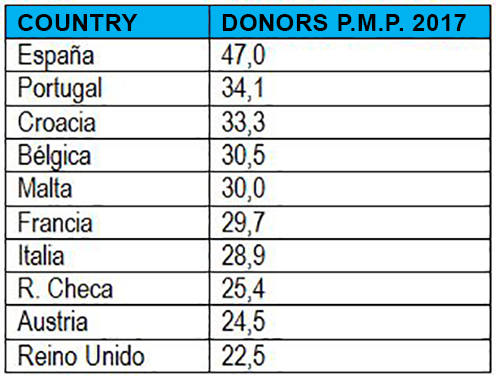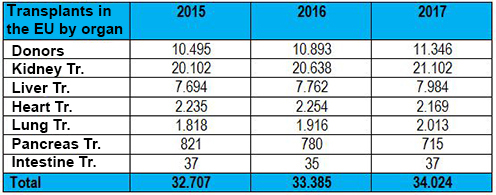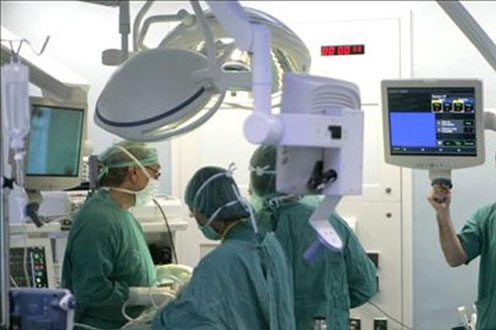The Spanish National Transplant Organisation has been managing this registry on behalf of the WHO for 12 years
World Transplant Registry reports 135,860 transplants performed worldwide last year, up 7.2%
News - 2018.8.29
This figure represents an increase of 7.25% on the previous year (126,670). Of that total, 89,823 were kidney transplants (40.2% live-donor), 30,352 were liver transplants (19.8% live-donor), 7,626 were heart transplants, 5,497 were lung transplants, 2,342 were pancreas transplants and 220 were intestinal transplants.
These transplants were made possible thanks to 34,096 deceased donors. This compares with a little over 31,000 in the previous year and represents an increase of 3.3%. These were joined by 42,154 live donors (36,125 live-donor kidney transplants, 6,012 live-donor liver transplants and 17 live-donor lung transplants).
These data are contained in the official publication by the CoE Committee on Organ Transplantation ('Newsletter Transplant 2017'), which will shortly be available on the ONT website (www.ont.es). Published by the ONT, 'Newsletter Transplant' is one of the main sources of official information in the world reflecting a large part of the data contained in the World Registry.
Spain, with 2,183 donors and 5,261 organs transplanted in 2017, once again reaffirms its global leadership for the 26th year running, with a rate of donors per million population (p.m.p.) of 47. The World Transplant Registry works with the population figures gathered by the United Nations Fund. This explains the slight difference between the rate recorded by the ONT at the end of 2017 (46.9), being marginally lower than the 47 donors p.m.p. attributed to Spain by the World Transplant Registry.
The World Registry data also reflect Spain's increasing contribution to total organ donation worldwide: Spain accounted for 19.2% of all organ donations in the European Union last year and 6.4% of worldwide donations, despite the fact that Spain only accounts for 9.1% of the total European population and 0.6% of the global population.
Clear leadership by Spain in transplantation
Spain's clear leadership in this field is also highlighted when analysing the organ transplants p.m.p. indexes, in which the country maintains its global leadership. Spain posted a figure of 113.4 transplants p.m.p. last year, far higher than the European average (66.9 p.m.p.) and also higher than the United States (109.7 p.m.p.).
It is worth pointing out that the World Transplant Registry now includes information on gender in its database. According to the figures in 2017 on 57 countries, 6 out of 10 live-donor kidney transplants and 4 out of 10 live-donor liver transplants came from women.
European Union
Both the number of donors and the number of transplants in Europe continues to increase slowly. In 2017, the organ donor rate in the 28 countries making up the European Union (EU) rose slightly to 22.3 deceased donors per million population, with a total of 11,346 organ donations.
The EU countries with the highest organ donation rate are as follows:

The following EU countries posted the highest organ donor rates
Those EU countries that have implemented the Spanish transplant model in whole or in part, such as Croatia, France, Italy and Portugal, continue to lead the ranking in terms of organ donor rates. Furthermore, the data highlight the improvement seen in the United Kingdom, which has posted a rate of 22.5 donors p.m.p. following efforts to enhance the role played by intensive care staff and ICUs in the identification of possible donors - one of the key measures in the 'Spanish model'. In contrast, Germany has posted a surprising decrease in its organ donor rate to only 9.7 donors p.m.p.
The total number of transplants in the EU stood at 34,024, compared with 33,385 recorded in the previous year.
Transplants in the EU by organ

As regards the waiting list, data from the World Registry put the number of European patients waiting for a transplant at 31 December at 56,399.
According to the same data, 10 patients died every day last year in the European Union while waiting for a transplant. As was the case in the previous year, this is a slight decrease.
Organ donor rates in other countries
The Council of Europe publication also includes data from Australia, Canada, the United States and Russia, as well as Latin American countries. The organ donor rate in the United States has risen to 31.7 donors p.m.p., with a total of 10,286 deceased donors. This increase has been boosted by the epidemic of deaths caused by parenteral drug use in the country.
Australia and Canada, which have received consultancy in this regard from Spain, have also posted improvements in their organ donor rates over recent years. Australia posted a figure of 20.8 donors p.m.p., while this figure stands at 21.9 donors p.m.p. in Canada and 4 donors p.m.p. in Russia.
Latin America, with which Spain has been working in this field for over 14 years now via the Iberoamerican Network/Council on Organ Donation and Transplantation (RCIDT) on both management consultancy and training for transplant coordination professionals, also posted an organ donor rate increase to 9.5 donors p.m.p., representing a total of 17,169 organ transplants. Since Spain began to cooperate in this regard in the region, total organ donation growth now exceeds 85%. This is the largest growth figure worldwide for a region as a whole.
Uruguay (with 18.9 donors p.m.p), Brazil (16.3 donors p.m.p) and Argentina (13.4 donors p.m.p) lead the table in terms of organ donor rates in Latin America.
Transplants in Spain continue to rise
The data from the World Transplant Registry once again confirm Spain's global leadership in this field, where a rate of 47 donors p.m.p. was recorded last year. A total of 2,183 organ donors were recorded in Spain, enabling 5.261 organ transplants to be performed. In total, 3,269 kidney transplants, 1,247 liver transplants, 304 heart transplants, 363 lung transplants, 70 pancreas transplants and eight intestinal transplants were performed.
Asystolic donation and collaboration from ER professionals with ICU staff and transplant coordinators on the identification of potential donors have become key factors in the increasing number of donors in Spain. In turn, Spain has extensive experience in organ donation from elderly donors with positive results, which is an area for potential improvement in other countries.
In Spain, 54.6% of donors are over 60. This is far higher than the percentage recorded in other countries, such as Australia (25.5%), the United States (12.5%), France (48.3%) or the United Kingdom (35.4%).
The upward trend posted in Spain in the field of organ donation and transplantation in recent years has continued into the first half of 2018, albeit at a slower pace. Data from the Spanish National Transplant Organisation on the first six months of 2018 reflect a 4% increase in the number of donors. The year-on-year rate has increased by 2%.
The ONT would like to stress that Spanish citizens needing a transplant are far more likely to receive one than anywhere else in the world.
Non official translation





